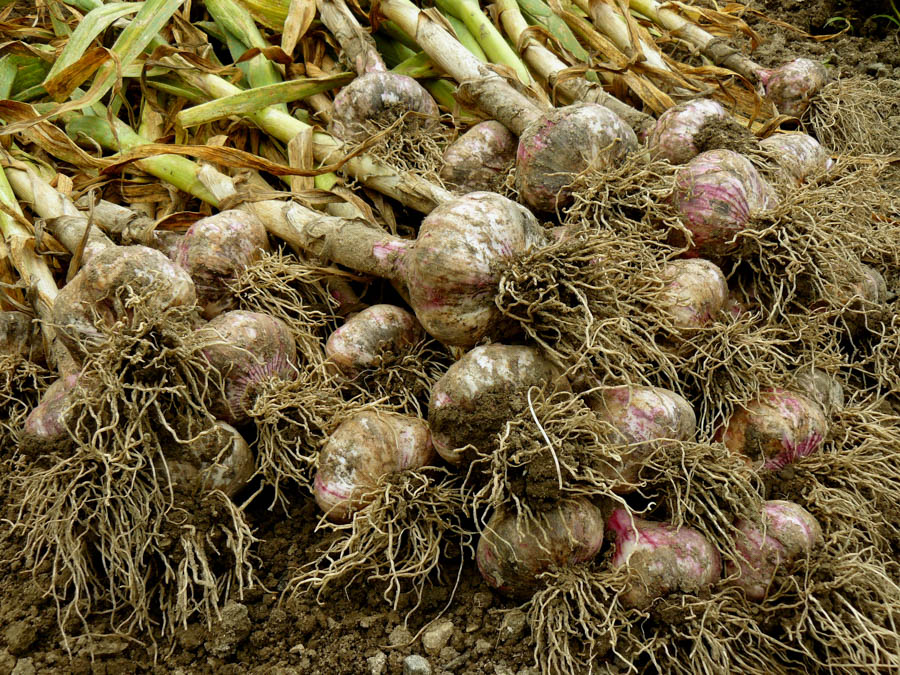Harvesting and Curing Garlic

A few simple tips and techniques can make the difference for an abundant, high-quality garlic harvest that stores well for long periods.
Season length to harvest can vary depending upon many environmental factors including seasonal temperatures and soil fertility. Most softneck garlic varieties need at least 6 months from fall through spring to reach maximum bulb size. Artichoke varieties under ideal conditions may have good bulb size within 5 months. Silverskin varieties may need 7-8 months or longer for full-sized bulbs.
Stop all fertilizing and amending of garlic 2-3 months before harvest. Minimize watering garlic for about 2-4 weeks before harvest, and discontinue watering entirely for at least 1-2 weeks before harvest (longer during cool weather). For best-quality bulbs, stop watering entirely when plants are nearing harvest and the lowest leaves turn yellow or brown. This usually begins a few weeks before bulbs are fully mature.
You will know that garlic is almost ready for harvest when leaves on mature plants begin to yellow and turn brown. This begins with the lowest leaves and continues upward. Harvest softneck garlics when the lower half of a plant’s leaves are yellowing to brown, and the upper half (about 4-5 leaves) are still green or mostly green. Timing of harvest is important. If you harvest too early bulbs may not be full sized or the paper covering of bulbs may be thinner, which may reduce the storage period. If you wait to harvest until all leaves are yellow or brown, cloves may burst through their skins, which also results in a short storage period.
Harvest garlic by removing the entire bulb from below. A garden fork is preferable to a trowel or bladed tools because the fork minimizes damage to bulbs and allows for harvest with roots still attached, which results in better curing and longer storage. Work around and underneath the bulb at a distance of an inch or two to loosen soil and remove the entire plant. Try to retain at least a few inches of roots. Avoid contact with the bulb, pulling by hand, or forcing when harvesting, which may split or harm bulbs and cloves. Any damage to bulbs or cloves will cause rapid deterioration and/or a short storage period. Avoid exposing bulbs to sunlight at any time after harvest and while curing.
Cure garlic bulbs after harvest, especially if they will be stored for more than a few weeks. The curing process closes off vascular tissues in stems and allows the skins on bulbs to harden, providing the best conditions for long storage. Smaller bulbs may be fully cured within a week or two during warm, dry weather; while larger bulbs may require 4 weeks or longer, especially during cool weather or under humid conditions.
Cure garlic bulbs either indoors or outdoors, and in a dry, shaded, cool-to-warm area with good air circulation. Carefully remove clumps of soil but avoid washing bulbs and leave stems and roots untrimmed while curing.
Braid garlic after plants have cured but while stems remain flexible. Retaining tops on garlic helps to extend storage period. For space-efficient storage after curing, stems can be trimmed to about 1 inch length above the bulbs, and roots should be trimmed to about 1/4 inch. Brush loose dry soil or loose skin layers off of bulbs before storing. If the bulb has multiple skin layers, remove the outer layer for cleaner storage with fewer fungal spores. Softneck garlics can be braided for hanging in bunches or in mesh bags.
If planning to replant from your own garlic harvest, save the largest bulbs as seed garlic for next planting season (larger cloves usually grow into larger bulbs). Sort out remaining undamaged bulbs for storage, and use any smaller bulbs, loose cloves, or damaged bulbs in the kitchen as soon as possible.
GardenZeus has customized gardening information by plant and zip code. To get started, enter your zip code here.
For more information about growing garlic:
Growing Garlic in the California Home Garden
Garlic Care and Maintenance in the California Home Garden
